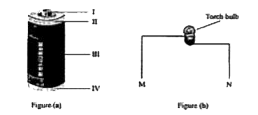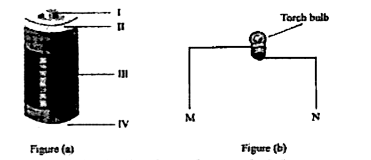Arjun creates a tester circuit with an LED and dips its free ends into the beakers of different liquids.In which of these liquids will the LED glow?
Distilled water
Tap water
Acetone
Spirit
The correct Answer is:B
To determine in which liquids the LED will glow when dipped into them, we need to understand the concept of electrolytes and how they conduct electricity. Here’s a step-by-step solution to the question:
Step 1: Understanding the Circuit
Arjun has created a tester circuit with an LED. The LED will glow if there is a flow of electric current through it. For electric current to flow, there must be free-moving charged particles (ions) in the liquid.
Hint: Remember that electric current requires charged particles to flow.
Step 2: Identifying the Liquids
The liquids mentioned are:
1. Distilled water
2. Tap water
3. Acetone
4. Spirit (alcohol)
Hint: Consider the properties of each liquid and whether they can produce free ions.
Step 3: Analyzing Distilled Water
Distilled water is pure and does not contain any dissolved salts or minerals. Since there are no ions present, it cannot conduct electricity.
Conclusion: The LED will NOT glow in distilled water.
Hint: Pure substances without impurities generally do not conduct electricity.
Step 4: Analyzing Tap Water
Tap water contains various dissolved minerals and salts, which can dissociate into ions. These free ions allow electricity to flow through the water.
Conclusion: The LED WILL glow in tap water.
Hint: Look for liquids that contain dissolved salts or minerals for conductivity.
Step 5: Analyzing Acetone
Acetone is a non-polar solvent and does not contain free ions. Therefore, it cannot conduct electricity.
Conclusion: The LED will NOT glow in acetone.
Hint: Non-polar solvents typically do not conduct electricity.
Step 6: Analyzing Spirit (Alcohol)
Spirit, like acetone, is also a non-electrolyte and does not produce free ions in solution. Hence, it cannot conduct electricity.
Conclusion: The LED will NOT glow in spirit.
Hint: Non-electrolytes do not dissociate into ions and cannot conduct electricity.
Final Conclusion
The only liquid among the options that will cause the LED to glow is tap water because it contains free ions that can carry electric current.
Final Answer: The LED will glow in tap water only.
Arjun has created a tester circuit with an LED. The LED will glow if there is a flow of electric current through it. For electric current to flow, there must be free-moving charged particles (ions) in the liquid.
The liquids mentioned are:
1. Distilled water
2. Tap water
3. Acetone
4. Spirit (alcohol)
Distilled water is pure and does not contain any dissolved salts or minerals. Since there are no ions present, it cannot conduct electricity.
Tap water contains various dissolved minerals and salts, which can dissociate into ions. These free ions allow electricity to flow through the water.
Acetone is a non-polar solvent and does not contain free ions. Therefore, it cannot conduct electricity.
Spirit, like acetone, is also a non-electrolyte and does not produce free ions in solution. Hence, it cannot conduct electricity.
The only liquid among the options that will cause the LED to glow is tap water because it contains free ions that can carry electric current.
Topper's Solved these Questions
- BOOK - PEARSON IIT JEE FOUNDATIONCHAPTER - CHEMICAL EFFECTS OF ELECTRIC CURRENTEXERCISE - CLASSROOM CORNER (LONG ANSWER TYPE QUESTIONS)14videos
CHEMICAL EFFECTS OF ELECTRIC CURRENT
- BOOK - PEARSON IIT JEE FOUNDATIONCHAPTER - KINEMATICSEXERCISE - LEVEL 318videos
KINEMATICS
- BOOK - PEARSON IIT JEE FOUNDATIONCHAPTER - DYNAMICSEXERCISE - CONCEPT APPLICATION(LEVEL 3)15videos
DYNAMICS
Similar Questions
A liquid is kept in a cylindrical vessel which is rotated along its axis. The liquid rises at the sides, if the radius of vessel is 0.05m and the speed of rotation is 2rev/s, find difference in the height of the liquid at the centre of the vessel and its sides.
View SolutionVarious parts on the outer surface of an electric cells are labelled as I, II, III and IV respectively in figure (a). In figure (b), an incomplete circuit is shown. M and N are the free ends of this circuit.

To make the bulb glow, free ends M and N of the circuit should be respectively connected toView Solution
Knowledge Check
- Question 1 - Select One
A capillary is dipped into a liquid which does not wet , the liquid level
Aremains the same in capillary as normal liquid levelBchanges in the capillaryCrises in he capillary than normal liquidDfall in the capillary than normal liquid level - Question 2 - Select One
When two capillary tubes of different diameters are dipped vertically, the rise of the liquid is
ASame in both the tubesBMore in the tube of larger diameterCLess in the tube of smaller diameterDMore in the tube of smaller diameter - Question 3 - Select One
A liquid is kept in a cylindrical vessel which is rotated along its axis. The liquid rises at the side. If the radius of the vessel is 5cm and the speed of rotation is 4rev/s, then the difference in the height of the liquid at the centre of the vessel and its sides is
A8cmB2cmC40cmD4cm
Various parts on the outer surface of an electric cell are labelled as I, II, III, and IV respectively in figure (a). In figure (b), an incomplete circuit is shown. M and N are the free ends of this circuit.

To make the bulb glow, free ends M and N of the circuit should be respectively connected toView SolutionThe product of the numbers 5623 and 6 in the scale of eight is
View SolutionDistillation is used to separate liquids which differ in their boiling point by
View SolutionA liquid is kept in a cylindrical vessel which is rotated along its axis. The liquid rises at the sides. If the radius of the vessel is r and the speed of revolution is n rotations/second, find the difference in height of the liquid at the centre of vessel and its sides.
View SolutionTwo capillary tubes of radii 0.2 cm and 0.4 cm are dipped in the same liquid. The ratio of height through which liquid will rise in the tube is
View Solution

